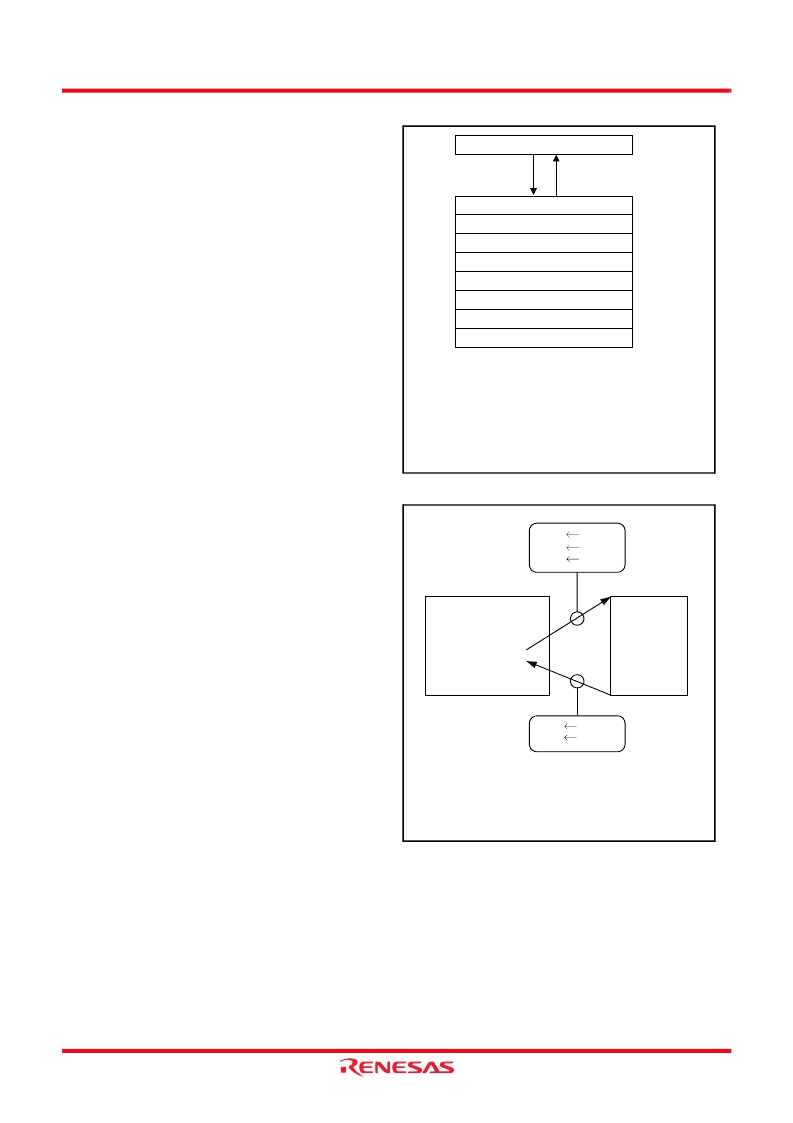- 您現(xiàn)在的位置:買賣IC網(wǎng) > PDF目錄359054 > M34571G4 (Renesas Technology Corp.) SINGLE-CHIP 4-BIT CMOS MICROCOMPUTER PDF資料下載
參數(shù)資料
| 型號: | M34571G4 |
| 廠商: | Renesas Technology Corp. |
| 英文描述: | SINGLE-CHIP 4-BIT CMOS MICROCOMPUTER |
| 中文描述: | 單芯片4位微機的CMOS |
| 文件頁數(shù): | 13/126頁 |
| 文件大小: | 1627K |
| 代理商: | M34571G4 |
第1頁第2頁第3頁第4頁第5頁第6頁第7頁第8頁第9頁第10頁第11頁第12頁當前第13頁第14頁第15頁第16頁第17頁第18頁第19頁第20頁第21頁第22頁第23頁第24頁第25頁第26頁第27頁第28頁第29頁第30頁第31頁第32頁第33頁第34頁第35頁第36頁第37頁第38頁第39頁第40頁第41頁第42頁第43頁第44頁第45頁第46頁第47頁第48頁第49頁第50頁第51頁第52頁第53頁第54頁第55頁第56頁第57頁第58頁第59頁第60頁第61頁第62頁第63頁第64頁第65頁第66頁第67頁第68頁第69頁第70頁第71頁第72頁第73頁第74頁第75頁第76頁第77頁第78頁第79頁第80頁第81頁第82頁第83頁第84頁第85頁第86頁第87頁第88頁第89頁第90頁第91頁第92頁第93頁第94頁第95頁第96頁第97頁第98頁第99頁第100頁第101頁第102頁第103頁第104頁第105頁第106頁第107頁第108頁第109頁第110頁第111頁第112頁第113頁第114頁第115頁第116頁第117頁第118頁第119頁第120頁第121頁第122頁第123頁第124頁第125頁第126頁

Rev.1.02
REJ03B0179-0102
May 25, 2007
Page 13 of 124
4571 Group
(5) Stack registers (SKS) and stack pointer (SP)
Stack registers (SKs) are used to temporarily store the contents of
program counter (PC) just before branching until returning to the
original routine when;
branching to an interrupt service routine (referred to as an
interrupt service routine),
performing a subroutine call, or
executing the table reference instruction (TABP p).
Stack registers (SKs) are eight identical registers, so that
subroutines can be nested up to 8 levels. However, one of stack
registers is used respectively when using an interrupt service
routine and when executing a table reference instruction.
Accordingly, be careful not to over the stack when performing
these operations together. The contents of registers SKs are
destroyed when 8 levels are exceeded.
The register SK nesting level is pointed automatically by 3-bit
stack pointer (SP). The contents of the stack pointer (SP) can be
transferred to register A with the TASP instruction.
Figure 11 shows the stack registers (SKs) structure.
Figure 12 shows the example of operation at subroutine call.
(6) Interrupt stack register (SDP)
Interrupt stack register (SDP) is a 1-stage register. When an
interrupt occurs, this register (SDP) is used to temporarily store
the contents of data pointer, carry flag, skip flag, register A, and
register B just before an interrupt until returning to the original
routine.
Unlike the stack registers (SKs), this register (SDP) is not used
when executing the subroutine call instruction and the table
reference instruction.
(7) Skip flag
Skip flag controls skip decision for the conditional skip
instructions and continuous described skip instructions. When an
interrupt occurs, the contents of skip flag is stored automatically
in the interrupt stack register (SDP) and the skip condition is
retained.
Fig 11. Stack registers (SKs) structure
Fig 12. Example of operation at subroutine call
Stack pointer (SP) points “7” at reset or returning
from RAM back-up mode. It points “0” by
executing the first
BM
instruction, and the
contents of program counter is stored in SK
0
.
When the
BM
instruction is executed after eight
stack registers are used ((SP) = 7), (SP) = 0 and
the contents of SK
0
is destroyed.
Program counter (PC)
SK
0
SK
1
SK
2
SK
3
SK
4
SK
5
SK
6
SK
7
Executing
BM
instruction
Executing
RT
instruction
(SP) = 0
(SP) = 1
(SP) = 2
(SP) = 3
(SP) = 4
(SP) = 5
(SP) = 6
(SP) = 7
(SP)
(SK
0
)
(PC)
0
0001
16
SUB1
(PC)
(SP)
(SK
0
)
7
Main program
Address
0000
16
NOP
0001
16
BM SUB1
0002
16
NOP
SUB1:
NOP
·
RT
Subroutine
Note :
Returning to the
BM
instruction execution
address with the
RT
instruction, and the
BM
instruction becomes the
NOP
instruction.
相關(guān)PDF資料 |
PDF描述 |
|---|---|
| M3488Q1 | 256 x 256 DIGITAL SWITCHING MATRIX |
| M3488 | 256 x 256 DIGITAL SWITCHING MATRIX |
| M3488B1 | 256 x 256 DIGITAL SWITCHING MATRIX |
| M3493B2 | CMOS 12 X 8 CROSSPOINTWITH CONTROL MEMORY |
| M3493B1 | CMOS 12 X 8 CROSSPOINTWITH CONTROL MEMORY |
相關(guān)代理商/技術(shù)參數(shù) |
參數(shù)描述 |
|---|---|
| M34571G4FP | 制造商:RENESAS 制造商全稱:Renesas Technology Corp 功能描述:SINGLE-CHIP 4-BIT CMOS MICROCOMPUTER |
| M34571G4-XXXFP | 制造商:RENESAS 制造商全稱:Renesas Technology Corp 功能描述:SINGLE-CHIP 4-BIT CMOS MICROCOMPUTER |
| M34571G6 | 制造商:RENESAS 制造商全稱:Renesas Technology Corp 功能描述:SINGLE-CHIP 4-BIT CMOS MICROCOMPUTER |
| M34571G6FP | 制造商:RENESAS 制造商全稱:Renesas Technology Corp 功能描述:SINGLE-CHIP 4-BIT CMOS MICROCOMPUTER |
| M34571G6-XXXFP | 制造商:RENESAS 制造商全稱:Renesas Technology Corp 功能描述:SINGLE-CHIP 4-BIT CMOS MICROCOMPUTER |
發(fā)布緊急采購,3分鐘左右您將得到回復(fù)。